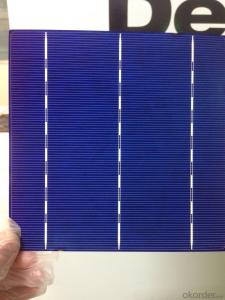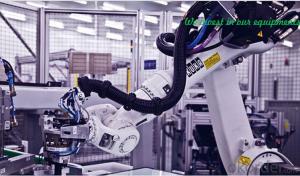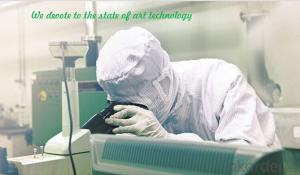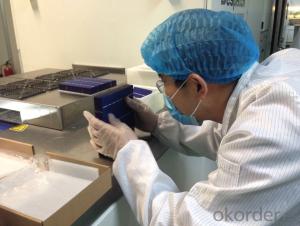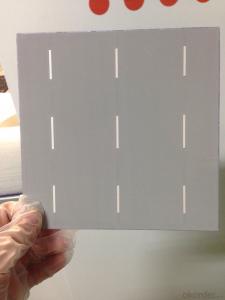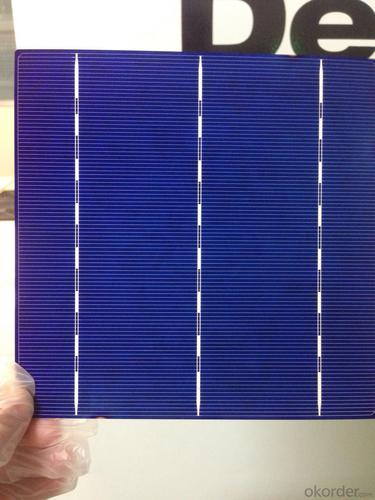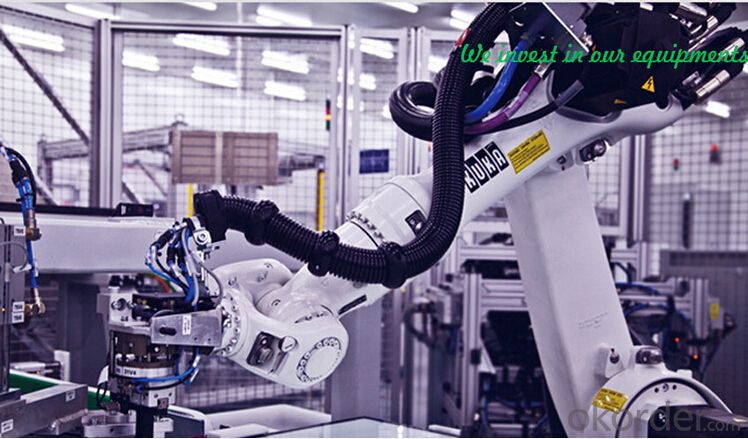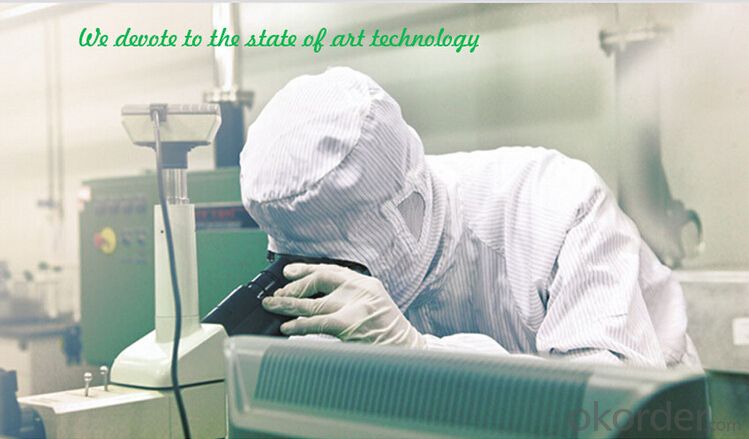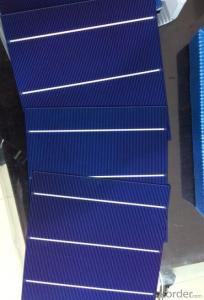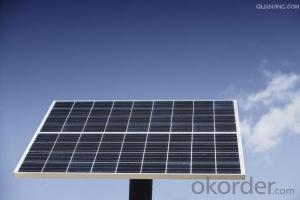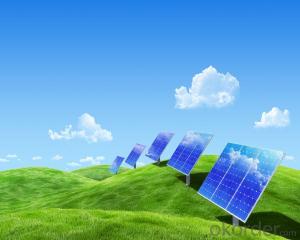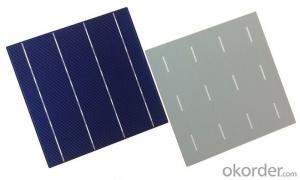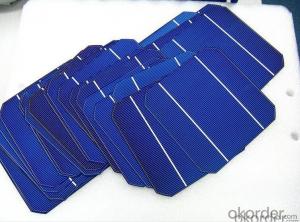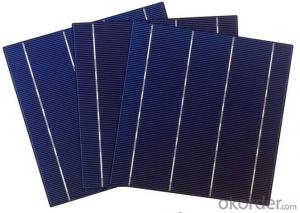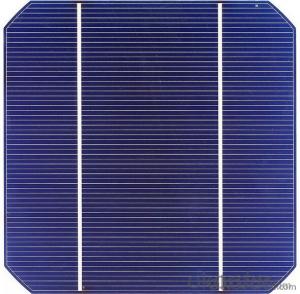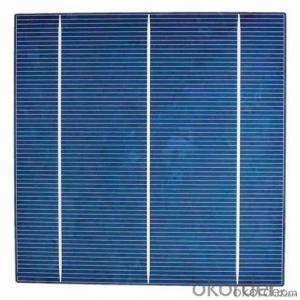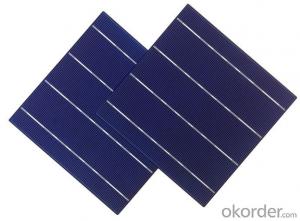Terrestrial Solar Cells - Low Efficiency and Low Power Solar Cells 3bb 17.2%
- Loading Port:
- Shanghai
- Payment Terms:
- TT OR LC
- Min Order Qty:
- 20000 pc
- Supply Capability:
- 2000000 pc/month
OKorder Service Pledge
OKorder Financial Service
You Might Also Like
Specification
Advantages of Poly Solar Cells
1. High efficiency and High power.
2. Long-term electrical stability.
3. Lowest price and Fastest delivery.
4. Good quality and good service.
5. Bulk supply
6. Good Warranty
7. Big Sale
8. More than 25 years on the lifetime.
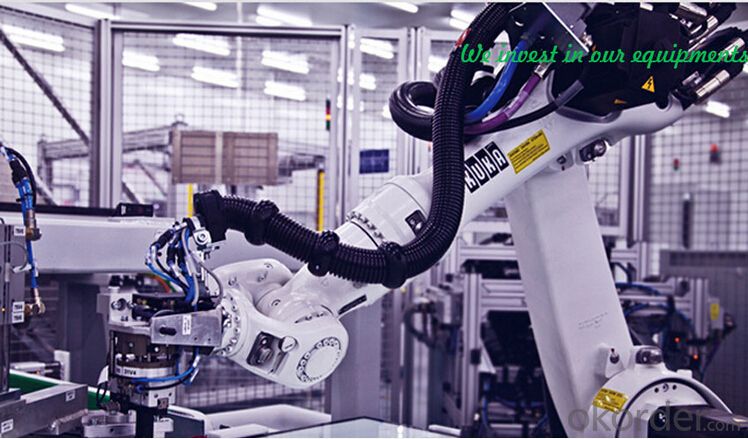
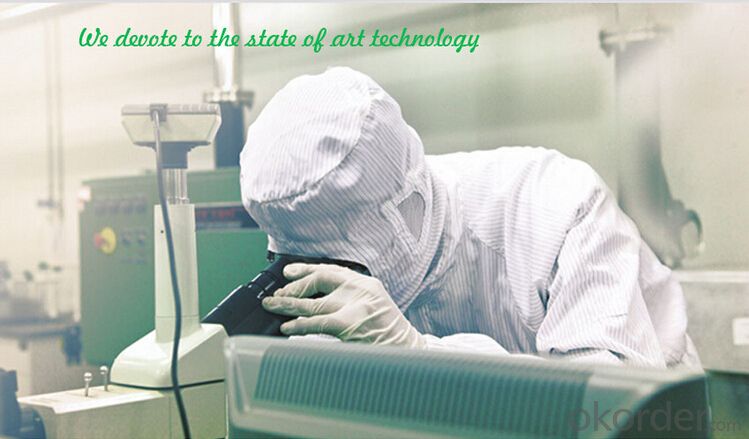
Temperature Coefficient of Monocrystalline Cells
Voc.Temp .coef.%/K:-0.351%/K
Isc.Temp .coef.%/K : +0.035%/K
Pm.Temp. coef.%/K: -0.47%/K
Visual Quality
CNBM Solar sorts cells into four blue color classes and clearly labels them on packaging and shipping documents.
Color uniformity within cells are closely monitored and controlled.
Gives modules a high quality look and feel.
CNBM Solar sets high visual quality standards, screening more than 25 visual criteria.
Performance in High Temperature
CNBM Solar cells produce optimal power output even in high temperature conditions.
Temperature coefficients average 0.1% per °C lower than the competition. This means 3% less power degradation when cell surface temperature increases from 25°C to 55°C.
Performance in Low Light
CNBM Solar Cells perform exceptionally well even in low light.
CNBM Solar A-grade and B-grade cells are screened for shunt resistance.
Higher shunt resistance can result in up to 10% higher annual energy yield for PV systems.
Low Reverse Current
CNBM Solar cells feature low reverse current at both -10V or -12V.
Reduces hot spot risk for long-term reliability.
Environmental Compliance
CNBM Solar cells are developed with environmental protection in mind.
All cells are RoHS compliant.
REACH-SVHC compliance ensures safe entry into the European market.
RoHS compliance: safe limits of Pb and no Cd found.
Usage and Applications of Polycrystalline Cells
Solar cells are often electrically connected and encapsulated as a module. Photovoltaic modules often have a sheet of glass on the front (sun up) side, allowing light to pass while protecting the semiconductor wafers from abrasion and impact due to wind-driven debris, rain, hail, etc. Our Cells can greatly improve the performance of Solar Modules.
Packaging & Delivery of Polycrystalline Cells
Carton Box Package and Deliver by air. It should be noticed that it should be avoid water, sunshine and moist.
FAQ:WHAT'S THE ADVANTAGES OF CNBM?
1.CNBM is a state-owned company under jurisdiction of central goverment , one of Fortune 500 .Just because of this ,we can get more support and resources from our government.So ,it is realiable .
2.CNBM's solar products are high-qualified with TUV,UL,VDE,CE,ISO certificates. Our products ranges top in China.
3.Just as I mentioned in attahment ,we signed 500MW project with Urkan under the witness of our chairman Xi Jinping ,CNBM has ability to meet your large quantity needs,Our annual capacity is 1GW.
FAQ: How many kinds of solar cells can we produce?
•: We can supply the normal 2 kinds of solar cells, Poly 156mm*156mm and Mono125mm*125mm , and the special demension also can be produced .
FAQ:What's the effeciency range of the solar cells?
•: We can supply 16.8% to 18.9% effeciency of the solar cells.
Cell-To-Module Performance (CTM)
1.CNBM Solar improves cell-to-module ratio by:
2.Narrowing down efficiency bin range to 0.2%.
3.Defining efficiency bins by minimal power and 97% of current at maximum power.
4.Customers can manage and control module power output distribution.
5.Customers get more value for their money.
6.Long-Term Reliability
7.High Shunt Resistance
8.Low LID (Light-Induced Degradation)
9.Frequent internal monitoring of LID.
- Q: Can solar cells be used in developing countries?
- Yes, solar cells can be used in developing countries. In fact, solar energy is an ideal solution for providing electricity in remote areas without access to a reliable power grid. Solar cells are cost-effective, require minimal maintenance, and can be easily installed in various locations. Moreover, using solar energy can help reduce reliance on fossil fuels, improve energy accessibility, and contribute to sustainable development in developing countries.
- Q: How do solar cells perform in areas with high levels of air pollutants?
- Solar cells may experience a decrease in performance in areas with high levels of air pollutants due to reduced sunlight reaching the surface. The presence of pollutants such as smog and particulate matter can block and scatter sunlight, thereby reducing the efficiency of solar cells. Regular cleaning and maintenance of solar panels can help mitigate the impact of air pollutants and ensure optimal performance.
- Q: Are solar cells impacted by shading?
- Yes, solar cells are impacted by shading. Even a small amount of shading can significantly reduce the efficiency and output of solar cells. Shading blocks sunlight from reaching the cells, which disrupts the flow of electrons and decreases the overall power generation. It is important to ensure that solar panels are installed in areas with minimal shading to maximize their performance.
- Q: What is 3d solar cell? And anybody know any manufacturers?
- 3d solar cells are more high efficient than the usual solar cells, and it's a new developed technology which is not used very widely. Therefore, there are not many manufcturers are producing it.
- Q: Can solar cells be used in agricultural farms?
- Yes, solar cells can be used in agricultural farms. They can be utilized to generate electricity for various purposes on the farm, such as powering irrigation systems, lighting, and machinery. Solar energy can help reduce dependence on fossil fuels, lower energy costs, and promote sustainable farming practices.
- Q: Can solar cells be used in smart home automation systems?
- Yes, solar cells can be used in smart home automation systems. Solar cells can generate electricity from sunlight and can be integrated into the smart home system to power various devices and sensors. This allows for energy-efficient and sustainable operation of the automation system, reducing reliance on conventional power sources and lowering electricity costs.
- Q: The working principle of solar cells includes the three processes
- The opposite of the electrical symbol of the photogenerated carriers in the solar cell pn junction built under the action of the electric field, the electron-hole pairs are separated, the electrons are concentrated on one side, the holes are concentrated on the other side, and the opposite sex charges are generated on both sides of the pn junction Of the accumulation, resulting in photogenerated electromotive force, that is, photovoltaic voltage.
- Q: Can solar cells be used in powering remote weather stations?
- Yes, solar cells can be used to power remote weather stations. Solar cells are a sustainable and efficient way to generate electricity, making them ideal for remote locations where access to grid power is limited. They can provide a reliable source of power for weather stations, allowing them to operate continuously and gather data even in remote areas.
- Q: Is the Solar Power Photovoltaic Cells the same as PV cells modules?
- According to the size and scale of the photovoltaic power station, the PV modules can be composed of various sizes and different arrays.
- Q: Can solar cells be used for air conditioning?
- Yes, solar cells can be used for air conditioning. Solar-powered air conditioning systems utilize solar energy to power the cooling process, making them more energy-efficient and environmentally friendly compared to traditional AC systems.
Send your message to us
Terrestrial Solar Cells - Low Efficiency and Low Power Solar Cells 3bb 17.2%
- Loading Port:
- Shanghai
- Payment Terms:
- TT OR LC
- Min Order Qty:
- 20000 pc
- Supply Capability:
- 2000000 pc/month
OKorder Service Pledge
OKorder Financial Service
Similar products
Hot products
Hot Searches
Related keywords
